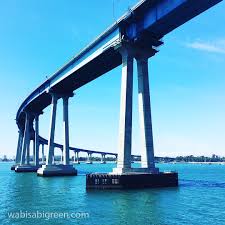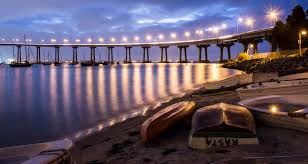San Diego, CA is the home of one of the largest U.S. Naval bases with 13 piers stretched over 977 acres of land and 326 acres of water. As a primary port for the Asia/Pacific region, the Navy has always had a very strong voice in public projects in San Diego that might impact the nation’s ability to defend and protect from outside attack. The approval for construction of the Coronado Bridge that connects San Diego to Coronado Island was under fierce debate between the Navy, policy makers and public for more than 40 years before it was finally supported in 1964 and completed in 1969. Initially, the obstacle was the U.S. Navy’s concern that in the event of an earthquake or enemy attack, the possible collapse of the bridge would cut off the Navy’s ability to leave San Diego Bay to do its work. By the 1950s, the Navy came around in its thinking and supported the bridge, but wanted accommodations made in the height to allow 200 feet of clearance for ships operating out of the Naval base. To achieve this clearance and avoid a steep grade, the bridge length was increased by taking a curved path, rather than a direct linear one to Coronado. By completion in August 1969, the bridge was 11,179-foot-long (3,407 m or 2.1 mi) with a 4.67 percent grade before curving 80 degrees toward San Diego from Coronado.
Making accommodations: What can the Coronado Bridge teach us?
Of all the bridges, this story perhaps most closely resembles the true nature of developing a business partnership–seldom a straight line; usually taking several twists and turns. It represents more than a compromise, which does often happen when coming to an agreement in a new relationship. Instead, it’s an accommodation made by the more advantaged partner (usually at some cost), in order to sweeten the arrangement for the other to agree.
I recall one specific partnership in which I had to broaden the targeted audience beyond my enterprise’s core constituency in order to support the interests and participation of the target partner. This meant developing a tangential business relationship to gain market distribution to the new audience. And, as you might imagine, there was an accommodation required by the tangential partner before acquiescing, which included a discounted price point. With agreements in place, a customized marketing communications plan was developed and executed, along with agreed upon metrics to track results for ROI reporting back to the initial partner. The results the first year were less than stellar, but the continued growth of the audience in the long term was seen as an added value to my enterprise’s overall objectives.
Part of a series: Causeways-business insight from the world’s most celebrated bridges
©2016, All rights reserved / www.karenwinston.com
To be clear, you do not have permission to take material from my blog and run it on yours.


